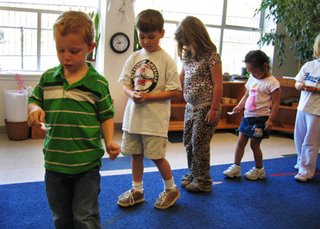After my recent post on using trial and error to make changes to your Montessori classroom, one reader asked me to elaborate on how to observe children while they work. This is a great topic, because when you observe you are getting to the heart of what Maria Montessori did to develop her method in the first place.
For me, being a naturally talkative and active person, the most important part of observation is to sit and be quiet. I can’t really take in what the kids are doing if I’m doing something too. If you’re a teacher, and someone is visiting or observing your classroom, they might be surprised to see you pull up a chair and sit in the corner of the classroom doing nothing – well, it might look like you’re doing nothing, but you’re taking in everything that’s going on in the room.

It helps to have a notebook or clipboard with you so that you can write down observations. Children can approach you for help during this time, but they should be instructed beforehand that if you are in your “observation corner”, they should always go to another child for help before coming to you.
The following suggestions can be used in a home or school environment, on a regular basis, or for a one-time visit to a school you might be considering for your child. Here are some things you can look for as you observe:
Observing One Child
• Is the child able to choose work independently? If not, who suggests the work, the teacher or another child?
• Do they get work out in the correct order – rug or table mat first, then the materials? Are the materials used for their correct purpose? Was the work complete, or did the child need to get materials from another area of the room?
• Does the child move purposely, or are their movements random?
• What stage of development is the child in – are they working to master the material, or have they mastered it and are now working towards perfection?
• When the child is finished working, how do they record their work, if at all? Filling out a worksheet, drawing a picture, making a booklet, writing a sentence, doing a project?
• Are they able to concentrate, and for how long? Is the concentration broken by disturbances in the classroom? Was the disturbance related to the choice of work space – too close to the door, or to the snack area? Do other children or teachers protect the child’s concentration? Can concentration be regained after being broken?
• Does the child demonstrate care for the environment, and if so, how?
Observing More than One Child
• Do children feel free to work together? Who chooses the work partners, the teacher or the children themselves?
• How do the children decide who does which part of the work? Do they share the work equally, or does one child do more than another?
• Can you find examples of the children cooperating with each other? Do you see them competing with each other? Is there something that stimulates cooperation or competition?
• Do the children in the room find their own source of help (a reference book, control card, or other child), or do they rely on the teacher?
• Do any of the children show leadership qualities? How are they demonstrated?
Answering these questions will help you to figure out:
1. How to best arrange the work space and the work on the shelves
2. Which presentations need to be refreshed – unrolling a rug, taking work from the shelves, or a specific presentation for a work that was done incorrectly
3. Which children are capable of independent work choices, and which ones need to work on that skill
4. Social skills that need to be taught or refined: cooperation, conflict resolution, helpfulness, respect
5. Whether or not the child understands the salient point of the work, and are able to record the work in a meaningful way after completion.
6. How much independence a child has developed, and what you can do to encourage more independence if needed.
I’m sure there are many other things that you’ll notice when you observe – and keep in mind, observation is the first step to dealing with any non-normalized behavior in the Montessori environment. You’ll have a much better idea of what needs to change once you see what’s actually going on.

